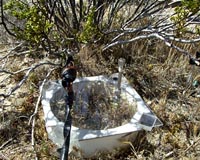Nitrogen loss threatens desert plant life
Ithaca NY (SPX) Nov 10, 2009 – As the climate gets warmer, arid soils lose nitrogen as gas, reports a new Cornell study. That could lead to deserts with even less plant life than they sustain today, say the researchers. As the climate gets warmer, arid soils lose nitrogen as gas, reports a new Cornell study. That could lead to deserts with even less plant life than they sustain today, say the researchers. “This is a way that nitrogen is lost from an ecosystem that people have never accounted for before,” said Jed Sparks, associate professor of ecology and evolutionary biology and co-author of the study, published in the Nov. 6 issue of Science. “It allows us to finally understand the dynamics of nitrogen in arid systems.” Available nitrogen is second only to water as the biggest constraint to biological activity in arid ecosystems, but before now, ecologists struggled to understand how the inputs and outputs of nitrogen in deserts balance. … “We’re on a trajectory where plant life in arid ecosystems could cease to do well,” she said. … “At 40 to 50 degrees Celsius [about 100-120 F], we found rapid increases in gases coming out of the soil” regardless of the light, McCalley said. Midday ground temperatures average about 150 F and can reach almost 200 F in the Mojave Desert. “Any place that gets hot and dry, in all parts of the world, will likely exhibit this pattern,” said Sparks. …
